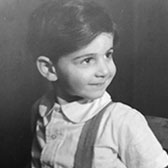
-
Learn More about Ralph
Ralph Berets’s first real memory during the war is of being warned that the Nazis had discovered his family’s hiding place. The younger son of a local farmer alerted his family to the approaching Germans. With two little children, and in the pouring rain, Ralph’s parents ran as fast and as far away as they could. Ralph distinctly remembers the sound of shouting and the sight of flames engulfing the cottage where his family had been hiding. Ralph later discovered that the farmer’s oldest son had betrayed Ralph’s family to the Nazis.
Biographical Information
Ralph Berets was born on December 5, 1939, in Amersfoort, the Netherlands. Before his birth, Ralph’s father, Otto, mother, Hilde, and grandparents, fled to Holland from Nazi Germany in 1935. Otto converted many of the family’s assets into diamonds and gold and smuggled them into the Netherlands. Once there, Otto went into the fabric business with an old friend from Germany who had relocated to the area a few years prior. The business was successful and provided the family with a comfortable middle class life style, until the German invasion of the Netherlands in May 1940.
Deportations of Jews from the Netherlands began in the summer of 1942. To avoid deportation, the Berets family found refuge in a cottage on a farm paid for and built by Otto with the help of his Christian friend, Soloman. The family lived there in relative peace for almost a year. The cottage was built on the property of a farm owned by Mr. Hendricks and his wife and children, a gentile family. One day, the youngest of Hendricks's sons ran over to warn the Berets family that the Nazis knew of their whereabouts and were on their way to apprehend them. Ralph and his family left immediately and hid in a nearby ditch. From there, they could hear the Nazis yelling that they knew Jews were living there. Since it was raining very hard, The Nazis stopped looking and then set fire to the cottage.
With nowhere to go, the family reached out to the Dutch Underground for assistance. Although Ralph and Marion were hidden separately from their parents, Ralph saw his mother on occasion. He would accompany Hilde on trips to gather food and other supplies as she felt a mother and a child would not draw as much attention as if she traveled alone. Hilde dyed their hair blonde to avoid suspicion. One day, while Hilde was visiting the home where Ralph and Marion were hiding, the Nazis came to check the house. The family hid in the attic crawl space. Marion, who liked the family cat, decided to bring the pet with her into the attic crawlspace. After hearing noise from above, the Nazis opened some boards aside that closed off the attic and the cat ran out. The Nazis believed they had found the source of the noise and left, without discovering Hilde, Marion, and Ralph.
The Berets spent the last year of the war hiding in a chicken coop near Arnhem, ultimately with a total of twelve people, including a number of close relatives. Conditions in the chicken coop were very poor. It was small, with only room for six places to sleep, so the inhabitants slept in shifts. It was stark, with only wooden planks on the ground and although there were no longer chickens living in the coop, their stench remained. The group survived in the chicken coop by foraging for food, surviving on potato peels, as well as the outer leaves of white cabbage. On special occasions, such as birthdays, Ralph received an egg.
On May 5, 1945, Canadian forces liberated Arnhem. Soldiers passed out chocolate bars and chewing gum to the young children. Ralph, who had never tasted chewing gum before, swallowed his pieces. The Berets returned to their home in Amersfoort only to find it occupied by German officers. It took the family six weeks to reclaim their property. In 1951, the family immigrated to the United States, where Ralph became an English professor at the University of Missouri. Ralph is a volunteer at the United States Holocaust Memorial Museum.



